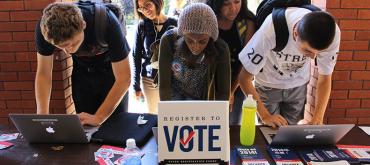
By the time polls close Nov. 6, nearly 13.3 million Floridians will have the opportunity to cast ballots for a governor, a U.S. senator and dozens of other state and local candidates.
New totals show that about 264,000 more voters are registered for the general election than were eligible to vote in the Aug. 28 primaries, with registered Democrats continuing to maintain a relatively small edge over Republicans.
Doubtless, political professionals have looked carefully at the new registration numbers to try to figure out what they mean for this year’s elections. But the numbers, posted on the state Division of Elections website, also offer an interesting peek at how Florida voter-registration patterns have changed during the past two decades --- a period of almost-total Republican control of state government that started when Gov. Jeb Bush was elected in 1998.
Here are five takeaways from the new numbers, looking at the short term and the long term:
THE BIG PICTURE: Going into the November election, 13,278,070 Floridians are registered to vote. That is up from the 13,013,657 who were registered to vote in the August primaries.
With Florida growing steadily for decades, it’s not surprising that the number of registered voters has also steadily climbed. During the last mid-term elections in 2014, for example, Florida had 11,931,533 registered voters.
In 1998, when Bush and Democrat Buddy MacKay ran for governor, Florida had 8,220,266 registered voters. And consider this: Sumter County had 26,002 registered voters in 1998. This year --- with the massive Villages retirement community helping fuel growth --- Sumter County has 96,497 registered voters.
NO PARTY, NO PROBLEM: Florida has 4,944,867 registered Democrats for the November election and 4,681,598 registered Republicans. That 263,269 margin is similar to the 245,301 difference in the August primary. Meanwhile, Republicans have narrowed the gap since the 2014 general election, when Democrats held a 455,946-voter edge.
But as Democrat Andrew Gillum and Republican Ron DeSantis run for governor and Democrat Bill Nelson and Republican Rick Scott run for U.S. Senate, the real story could be in voters categorized as “no party affiliation.” That fast-growing group totals 3,549,094 registered voters for the November election, up from 2,778,547 in 2014.
The trend is even more pronounced in the long term: In 1998, no-party voters made up about 13.5 percent of the total voters. This fall, they make up 26.7 percent.
WHERE THE VOTES ARE (AND AREN’T): With time dwindling before the November election, don’t be surprised if you see the statewide candidates --- particularly Democrats --- spending much of their time in Southeast Florida, Orlando and the Tampa Bay area. The reason is fairly straightforward: That’s where the votes are.
Combined, Miami-Dade, Broward and Palm Beach counties have nearly 3.54 million registered voters, or more than a quarter of the overall total. Add in Orange, Pinellas and Hillsborough counties and the total grows to 5.86 million, or about 44 percent of the total. All six of the counties have more registered Democrats than Republicans, though Pinellas is almost evenly split.
On the other end of the spectrum, the six counties with the fewest voters --- Lafayette, Liberty, Glades, Union, Hamilton and Franklin --- combine for a total of 38,420. Lafayette and Liberty each have fewer than 5,000 registered voters, while the others are below 8,000.
SOUTHERN DEMOCRATS NO MORE: While registered Democrats outnumber Republicans in the state’s urban counties, the GOP has the advantage in large swaths of the state, including dominating in mid-sized counties. The GOP has a registration edge in 42 of the 67 counties heading into the general election.
Voters in much of Florida have always been conservative, but the days of the traditional Southern Democrats are largely gone. Democrats still have more registered voters in many rural parts of the state, but 25 counties have flipped from Democrat to Republican in registration advantages since 1998.
In 1998, for example, registered Democrats made up slightly more than half of the voters in Bay County; now they make up about a quarter. In nearby Walton County, Democrats made up 59 percent of the registered voters in 1998; now they are about 19 percent. In another Panhandle county, Holmes, Democrats made up 86.6 percent of registered voters in 1998; now they are about 30 percent.
SOME DEMOCRATIC MAGIC: While Democrats have lost ground in registration in many parts of the state, they have been buoyed by changes in the Orlando area. Orange County has 798,373 registered voters for the November election, including 339,550 registered Democrats and 211,038 registered Republicans.
That represents a massive change over the past two decades. In 1998, Orange County had 353,852 registered voters, with Republicans slightly outnumbering Democrats by about 6,000 voters. The number of no-party voters in the county also surged during the period, going from 49,082 in 1998 to 241,405 this year.
Democrats also have built a big advantage in neighboring Osceola County. The percentage of voters registered as Democrats has remained about the same compared to 1998, at slightly less than 43 percent. But registered Republicans have dropped from 37.4 percent to 22.6 percent.


